🏢 Smart Facility Planning Takeaways
- Tailored Facility Condition Assessments (FCAs) help federal, municipal, and private owners prioritize safety, compliance, sustainability, and ROI through customized, data-driven reports and actionable timelines.
- Federal, municipal, and private sectors benefit differently: federal owners focus on compliance and energy goals, municipalities prioritize safety and cost-efficiency, while private owners use FCAs to guide investment and portfolio decisions.
- Strategic FCAs support funding and planning by identifying urgent needs, extending asset life, and justifying capital improvements – turning assessments into powerful tools for smarter facility management.
Every smart building decision starts with accurate data. Facility condition assessments (FCA) uncover what’s really happening at your site – helping you spot issues early, prioritize improvements, and make the most of your budget.
But here’s the key: no two assessments are the same. Federal, municipal, and private owners all bring different priorities to the table regarding safety, sustainability, compliance, and return on investment (ROI). The best assessments are tailored to your specific goals, with the final report outlining recommended actions by urgency: six months, one year, three years, and beyond. Safety and code compliance issues are flagged immediately, and other findings are presented alongside practical, cost-effective plans that align with your long-term objectives.
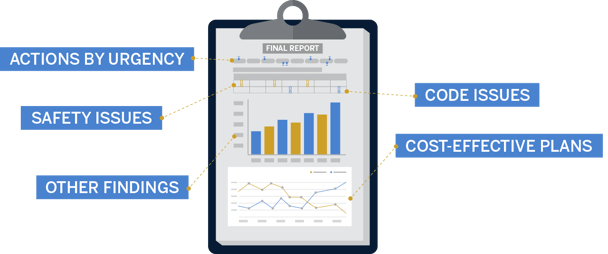
To break it down, mechanical engineer Matt Massa offers key tips and insight into how these assessments can give your facility the strategic edge.
What Is a Facility Condition Assessment?
Think of it like a check-up at the doctor’s office – only for your building. A team of experts takes a close look at your facility and identifies what’s working, what needs attention now, and what can wait until later. From there, you get clear, step-by-step actions.

Typical assessments cover:
- HVAC, plumbing, power, and lighting systems
- Life safety and security systems
- Building envelope, finishes, and roof
- Exterior elements like sidewalks and parking lots
- ADA and code compliance studies
For many, the assessment becomes a roadmap: showing where to invest first, how to plan maintenance over time, and even how to make a stronger case for funding. But the roadmap only works if it’s built with the right priorities in mind.
Federal Owners: Compliance and Sustainability
Federal facilities face strict standards – code compliance, accessibility, and sustainability targets are non-negotiable. Assessments here often emphasize documentation that stands up to audits and funding requirements.
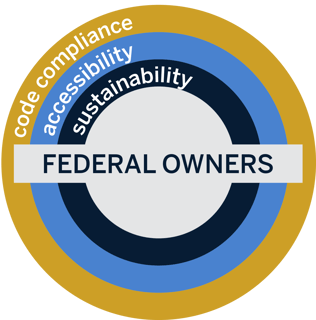
Example: A client with a large portfolio also had a big push for energy efficiency. The team combined condition assessments with energy audits, creating models that showed which improvements would have the biggest sustainability impact. That clarity drove strategic funding decisions.
Bottom line if you’re a federal owner: assessments double as both a compliance check and a roadmap for meeting ambitious energy and sustainability goals.
Municipal Owners: Safety and Cost Efficiency
Municipalities often manage aging infrastructure with limited budgets. Here, the focus is on prioritizing the most critical needs – especially safety, code compliance, and cost efficiency – while stretching every dollar. They also bring peace of mind: urgent issues surface quickly, and budgets go further.
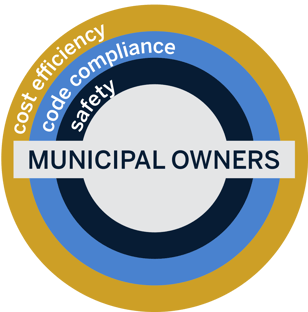
Example: At a facility with two redundant chillers, staff explained that one unit had failed early, forcing the other to work overtime. That insight helped adjust life expectancy estimates and gave the owner a heads-up to plan for earlier replacement.
If you’re a municipal owner, assessments must also be easy to communicate. Findings may be used to support council presentations, justify budget allocations, or make the case for a bond referendum.
Private Owners: ROI and Flexibility
Assessments can be used to help weigh whether to hold, sell, or reinvest in an asset. The focus here is ROI and long-term value. By using assessments, investors can make confident decisions with greater clarity.
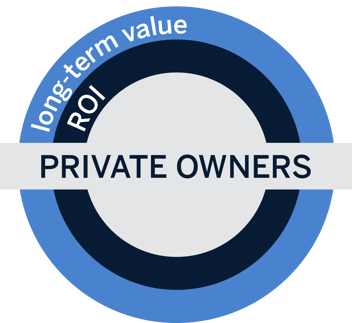
Example: An owner requested an assessment before purchasing a facility. Even though the building was in excellent condition, the assessment revealed it wasn’t the right fit for their hybrid workforce. The report gave them the confidence to walk away.
If you’re a private owner, assessments aren’t just about maintenance – they’re decision-making tools that directly influence portfolio strategy.
Best Practices Across All Sectors

Most organizations complete assessments every three to five years. The best results come when you:
- Revisit the report during budget planning
- Update costs with new quotes
- Track completed projects
- Reprioritize as needs shift
The more you revisit the assessment, the fewer surprises you’ll face next time. No matter the sector, keeping your assessment current ensures you’re always working with the best information.
How It Helps with Funding
You’re dealing with a tough mix: aging infrastructure and limited funds. Budgets are tighter and there’s more competition for funding. Assessments give expert recommendations and documentation needed to justify investments and make smart decisions.

Assessments often provide the evidence needed to unlock funding or justify capital improvements. Detailed findings tied to costs and real impacts can strengthen grant applications, bond requests, or budget proposals. In some cases, they help free up funds that would otherwise be tied to oversized fixes.
Example: An owner set aside $1 million for a full roof replacement. The assessment showed targeted repairs could extend the roof’s life for a fraction of the cost. That created space in the budget for other priority projects.
Getting Started: Define Your Goals
The most useful assessments begin with clear objectives. Ask yourself “Am I looking to...”:
- Extend facility life?
- Improve sustainability?
- Justify funding requests?
- Identify underperforming assets?
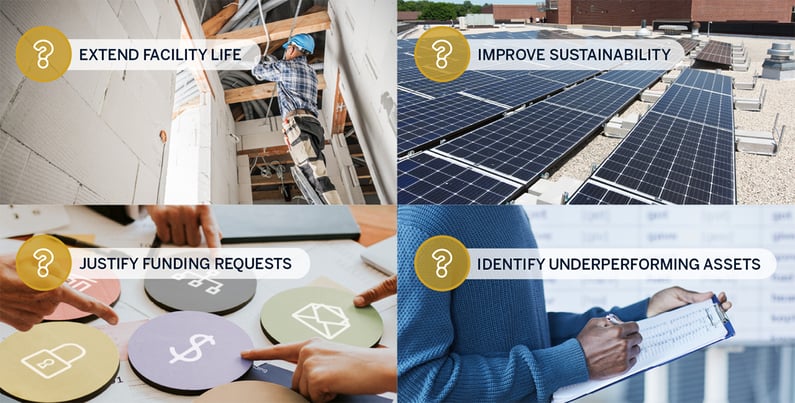
Knowing your goals upfront helps your team deliver recommendations tailored to your priorities – whether compliance for federal facilities, safety for municipalities, or ROI for private owners.
The Real Value: Clear, Tailored Recommendations
No matter the sector, assessments replace assumptions with facts. You walk away with data-driven findings, recommendations, estimated costs, and a clear roadmap you can act on. When the process is tailored, the findings become actionable instead of overwhelming, and owners can move forward with clarity and confidence.
Keep in mind, assessments are not pass/fail inspections, audits of your maintenance staff, or one-size-fits-all checklists. They are collaborative action planning, decision-making tools backed by data, and customized roadmaps built around your goals.
How It All Adds Up
Good care goes a long way – sometimes an older system outperforms a newer one. When assessments are aligned with your specific goals as an owner, the results offer smarter, more strategic, and cost-effective solutions so your facility performs efficiently and reliably into the future. If you’d like to learn more about keeping your operations at their best, reach out to Matt.
About the Expert

Matt Massa, PE*, is an SEH principal, mechanical engineer, project manager, and mechanical and electrical team leader. With over 17 years of professional experience, he has worked in multiple industries across the country. He collaborates closely with SEH's architecture, civil, and structural practices, providing engineering services to public, private, and federal clients. With versatility, practical knowledge, and a commitment to excellence, Matt helps clients and owners make smart decisions and better serve their communities.
*Registered Professional Engineer in AZ, CA, CO, FL, MT, NE, NY, UT, WA, WY

.png?width=113&name=SEH_Logo_RGB%20(1).png)
